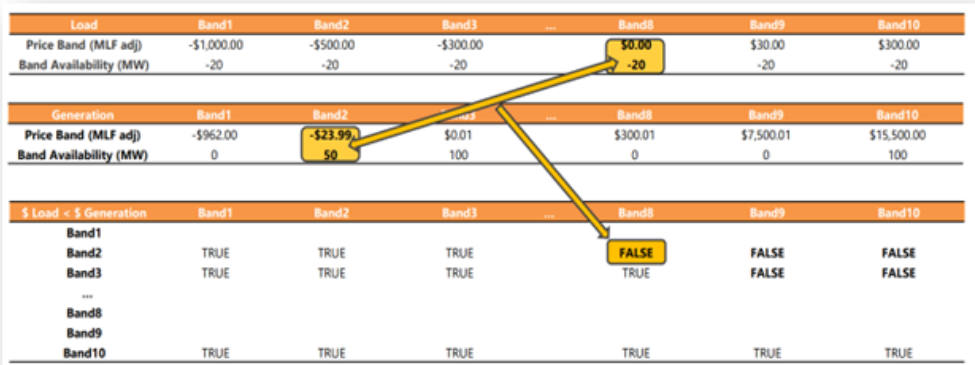Validation for Bid convexity and monotonically increasing values
This validation prevents the concurrent dispatch of consumption (load) and generation bands.
Bid See Relevant Rules or Procedures submissions and validations:
- BDU Bi-directional Unit. A bi-directional unit capable of charge and discharge; for example, battery technologies. energy bid submission for a trading day must include Direction for LOAD and GEN (energyBids object), that is, a separate energyBids object and associated energyPeriods array for the load and generation side of the BDU.
- prices (the band price) and band availability (bandAvail1 to bandAvail10) provided for LOAD and GEN bid.
-
An Effective Band refers to an energy bid band (bandAvail) with non-zero MW capacity limited by bid MaxAvail, non-zero availability.
- MLF-adjusted prices for these effective bid bands must monotonically increase from LOAD bandAvail1 to bandAvail10 to GEN bandAvail1 to bandAvail10.
- Effective LOAD bands are validated against effective GEN bands in the same energy bid submission.
- Loss factor-adjusted band prices for these effective bands must monotonically increase from LOAD bandAvail1 to bandAvail10 to GEN bandAvail1 to bandAvail10.
- For all trading intervals:
- Maximum Effective LOAD band price / LOAD Loss Factor must be less than
- Minimum effective GEN band price / GEN Loss Factor.
- Bidding MaxAvail = 0 on LOAD side allows the participant to shift band MW capacity into MFP-priced GEN Band 1 without violating the bid convexity rule.
This allows the BDU to compete with other BDU's and Generators See Relevant Rules or Procedures at the MFP Market Floor Price. The National Electricity Rules’ minimum at which gas can be bid, offered, or scheduled in the market. The AEMC’s Reliability Panel reviews the MFP every four years.(and vice versa applies).
